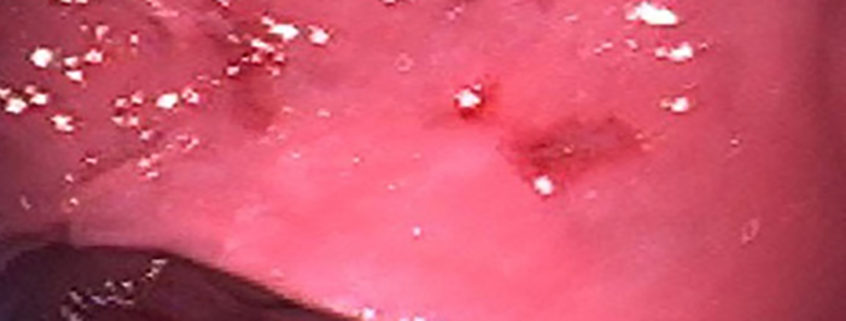Update on acid suppressant therapy
Sarah Cocker, DVM
Veterinary Specialty Hospital by Ethos, San Diego, CA
Posted on 2016-11-15
Ulcerative disease occurs secondary to an imbalance between gastric acid secretion and gastric mucosal defense mechanisms. The parietal cell is the key cell in gastric acid secretion and is found lining the body of the stomach. The parietal cell utilizes a H+/K+-ATPase pump to secrete hydrogen ions. There are three substances that stimulate H+ secretion by gastric parietal cells: histamine, acetylcholine, and gastrin.
The normal gastric pH is between 1-2. In experimental animal models of esophagitis, Lanas, et al. showed that infusion of hydrochloric acid into the esophagus alone was associated with minimal to no esophageal damage, but infusion of pepsin and hydrochloric acid resulted in micro and macroscopic evidence of esophagitis. Thus, pepsin and hydrochloric acid are necessary for damage to occur. The pH range for the conversion of pepsinogen to pepsin is between 1.5 and 3.5, thus a pH goal of ≥3.5 is ideal to prevent esophagitis. While an optimal pH for healing of gastroduodenal ulcers in animals is not known, in people, optimal gastroduodenal ulcer healing and treatment of gastroesophageal reflux disease occur at an intragastric pH of ≥3 for approximately 75% of the day, and a pH of ≥4 for ≥67% of the day, respectively.
H2 Receptor Antagonists (H2RA)
This class of medications competitively inhibits binding of histamine to H2 receptors on parietal cells. In descending order of potency: famotidine, ranitidine, nizatidine, and cimetidine are all reversible H2 specific receptor antagonists. H2RAs reach peak plasma concentration within a couple of hours of administration of the first dose. H2RAs are much weaker acid suppressants than PPIs and increasing the dose or frequency of administration of famotidine above 1 mg/kg q12h has not been shown to increase effectiveness.
Proton Pump Inhibitors (PPI)
PPIs are the most potent inhibitors of gastric acid secretion available and are longer lasting than H2RA. After oral administration PPIs enter the blood stream then diffuse into parietal cells wherein an acidic environment they are protonated and trapped within the cell where they cause irreversible inhibition of the H+/K+-ATPase pump. Acid secretion only resumes when new proton pumps are synthesized in the parietal cells. After initial administration of a PPI, previously dormant parietal cells are activated, thus inhibition of acid secretion is approximately 30% of maximum on day 1 of administration. Maximum inhibition occurs within 2-4 days of PPI administration. Drugs in this class include omeprazole, pantoprazole, esomeprazole, lansoprazole, rabeprazole, and dexlansoprazole; with the first 3 being the most commonly used in veterinary medicine.
Many veterinarians have administered H2RAs in conjunction with PPIs in an effort to have a stronger and more rapid effect on gastric pH. However, studies have shown that this is not necessary as an optimal pH can be achieved rapidly with PPIs alone and co-administration of H2RAs could theoretically decrease the efficacy of PPIs due to the requirement for PPI activation and trapping in the acidic canalicular environment of parietal cells. Unpublished data from UC Davis found that administration of only two doses of omeprazole 18-24 hours apart in 10 cats resulted in a mean gastric pH of 7.2 compared to a pH of 2.8 with placebo administration. Tolbert, et al. showed that co-administration of pantoprazole and famotidine was not superior to administration of pantoprazole alone in healthy dogs.
Multiple veterinary studies have found that PPIs administered at 1 mg/kg q12h provide the most significant acid suppression over a 24-hour period, and this dose is necessary to achieve the gastric pH recommended for ulcer healing in people. Omeprazole tablets are enteric coated and therefore cannot be crushed, but halving the tablets has shown to still be effective in cats.
Commonly reported adverse effects of long term administration of acid suppressants in people include vitamin B12 deficiency, diarrhea, enteric infectious (particularly Clostridium difficile), increased risk of hospital-acquired pneumonia, and the potential increased risk of fractures in geriatric people. Long-term adverse effects in animals have not been thoroughly evaluated. Diarrhea is the most commonly reported side effect in dogs. A recent study evaluating administration of 1 mg/kg q12h omeprazole in 6 cats for 60 days found no significant changes in hematological or biochemical parameters, including cobalamin and methylmalonic acid. The study did show a decrease of >8% in bone mineral density in 4/6 cats and a significant rebound in acid secretion in 2 cats (pH < 1.5 for several days) post sudden cessation of omeprazole. This study suggests that PPIs should be gradually tapered after prolonged administration.
About the author
Dr. Cocker enjoys many aspects of internal medicine, but has special interests in gastrointestinal and hepatobiliary diseases. In her free time, Dr. Cocker enjoys spending time with her fiancé and their 5 fur babies (two dogs, two cats, and a rabbit). |




